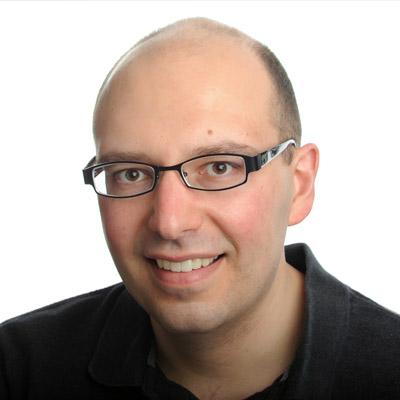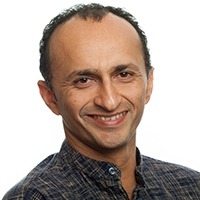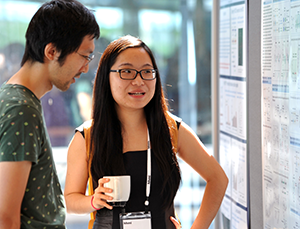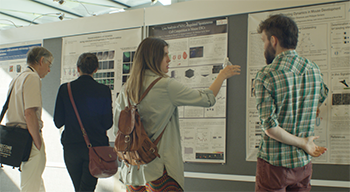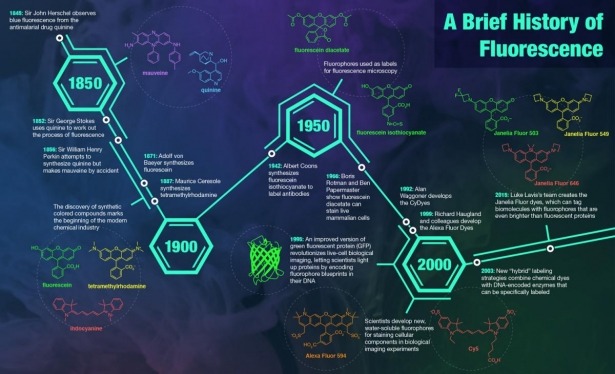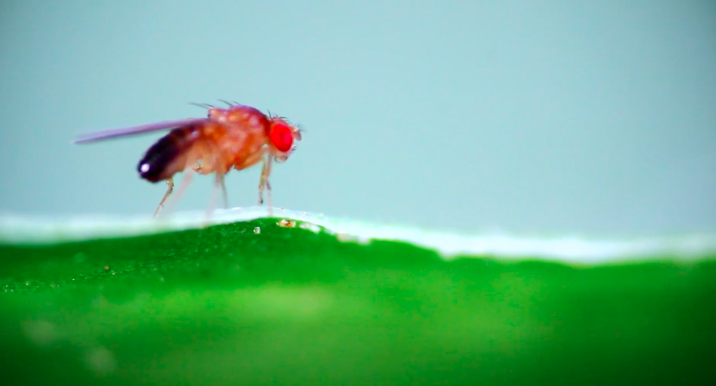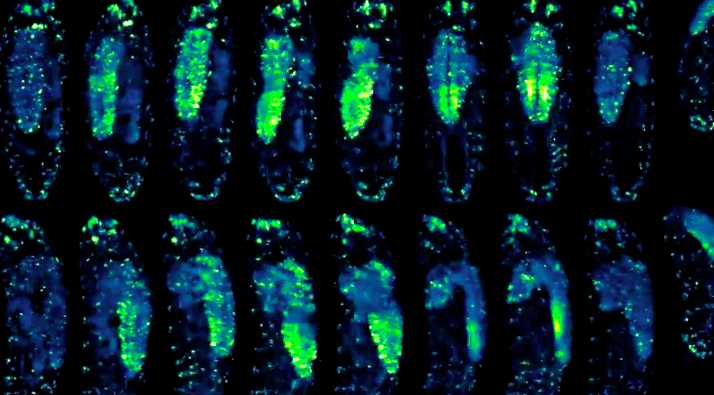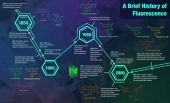Gwyneth Card knows exactly how a fruit fly reacts when a predator looms into view. The initial freezing response, the readying of the legs and wings for a takeoff, the powerful downstroke or hurried kick that finally launch an escape—she’s seen it all thousands of times.
As a graduate student in Michael Dickinson’s lab at Caltech, Card was the first to characterize the precise actions a fly uses to escape a threat. Now, as a Janelia Group Leader, she’s probing the neural circuits that control those responses—tracing the exact cells the fly’s brain uses to size up a threat and determine when and how to flee.
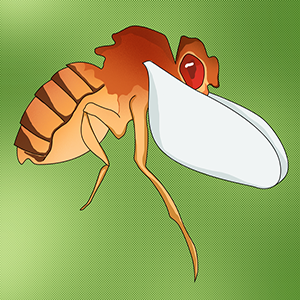
Card came to Janelia in 2010, soon after finishing her PhD. In Dickinson’s lab, she had studied flies’ escape behavior closely enough to recognize that it was remarkably complex, with responses tailored to the nature of a particular threat. To extend that work, she wanted to know how the brain was driving those behaviors and making what appeared to be fairly sophisticated decisions every time a threat approached.
Although she knew it wasn’t a traditional career path, building her own research program at Janelia felt like the logical next step. She worried that working as a postdoctoral fellow in someone else’s lab would have limited the scope of her investigations; however, as an independent scientist she would be able to devote all of her lab’s resources to the questions she found most compelling. So when Janelia offered her a position as lab head, Card didn’t think twice.
When she arrived on campus, her head buzzing with plans, her new lab was stark and pristine. Equipment had to be ordered, staff hired, and experimental systems set up. “It was wonderful and daunting to walk into an empty room and know it was my job to create science,” she recalls.
It was wonderful and daunting to walk into an empty room and know it was my job to create science.
Most of the work in the early days involved setting up what Card calls an IMAX dome theater for fruit flies, which is now the centerpiece of her lab. Inside the theater, flies experience visual cues that suggest an approaching object, which could signal a potential predator. Thousands of flies can be automatically released into the theater each day, and Card and her team have set up their system to capture each one’s response to the simulated threat on high-speed video.
Invariably—as long as their nervous systems are intact—the flies flee. Card and her team are focused on the finer points of each fly’s escape. By studying how escape behavior changes in flies in which certain neurons have been switched off, then further monitoring and manipulating neural signaling, the researchers are dissecting the neural circuits that underlie this vital response.
Once she got her research going and began collaborating with Janelia colleagues, progress came quickly. “We’ve started to be able to say a lot more about visually guided behavior in the fly, both on the sensory and motor processing sides,” Card says. She and her collaborators have identified neurons that encode visual features of a fly’s world, including cells specialized to detect looming stimuli. By tracing those cells’ connections to others that pass the sensory information along and coordinate an appropriate behavioral response, they are beginning to understand the underlying architecture of the relevant brain circuits.
Card says starting her lab straight out of graduate school helped her maintain momentum and enthusiasm for her research. “I’ve really benefited from early on, really having the work I do be a product of my own curiosity,” she says.

Like Card, Philipp Keller finished his PhD feeling energized. As a student in Ernst Stelzer’s laboratory at the European Molecular Biology Laboratory (EMBL), Keller had worked with a cutting-edge imaging technology called light sheet microscopy. The method, developed in Stelzer’s lab, excels at imaging three-dimensional samples at high resolution over prolonged periods, which Keller realized made it ideal for following the movement of cells in a developing embryo. Making some adaptations to the technology, he used it to generate a movie that revealed exactly how a small cluster of zebrafish cells transformed themselves into an embryo with a beating heart.
Excited about that success, Keller envisioned a next-generation microscope that would allow him to really address fundamental questions about how organisms form in a comprehensive, quantitative manner. “There was so much more that still could be done,” he says. “What I had done was only a starting point.” So when Janelia offered him an opportunity to run a research group of his own, Keller couldn’t turn it down. “It was the right place and time to do this,” he says.
There were plenty of uncertainties about accepting the job at the still-young research campus, and advisors cautioned him that becoming independent so early in his career could feel like a sink or swim situation. “But the sense I got was that Janelia was trying to make it easy to say 'yes' to that opportunity,” he says. At Janelia, Keller would be able to apply his technology to the biological questions he cared about most. And he would focus fully on his research, without the additional responsibilities that typically come with academic appointments. What else could he ask for?
Choosing riskier projects allows us to take two steps forward instead of one.
Keller hired two EMBL colleagues to join his lab at Janelia, and the threesome worked to make digital light sheet technology even more powerful, imaging embryos as they developed over even longer periods. As his team slowly expanded, he began exploring new ways to image the neural circuits that many of his Janelia colleagues were studying. “Some of our very best and most interesting projects came out of these collaborations,” he says.
In 2013, Keller’s team announced that, together with Janelia colleague Misha Ahrens, they had devised a method of imaging neuronal activity throughout the entire brain of a zebrafish. Now, improvements to their imaging technology are allowing them to track the development and function of hundreds of neurons as they wire up to allow a zebrafish embryo to begin to flick its tail, as well as to follow the assembly of the nervous system in mice over two full days of development. That’s important, because biologists won’t fully understand these circuits until they see how they’re built, Keller says.
Keller came to Janelia to follow the ideas he had about imaging and development—but he never could have predicted the paths his research would take, he says. With a small team, his group can never take on all the projects they dream up, but they want to make sure their work has the maximum impact on biology. “Choosing riskier projects allows us to take two steps forward instead of one,” he says.
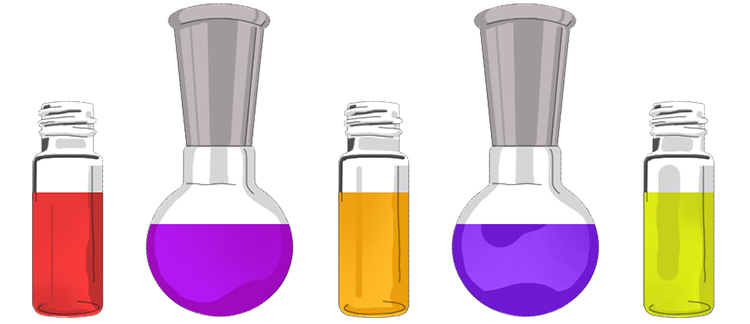
Luke Lavis has spent his career developing fluorescent dyes that biologists can use to light up molecules of interest in cells and living animals, bringing them into clear view under their microscopes. A decade after arriving at Janelia, and now a Senior Group Leader, he still marvels at his opportunity to focus deeply on the chemistry he loves.
For the first few years after completing his undergraduate degree at Oregon State University, Lavis worked at small biotechnology companies, where new reagents were developed quickly, and he and his colleagues were on to the next project by the time their product was released to users. Hooked on small molecule dyes, he enrolled in a PhD program at the University of Wisconsin and developed fluorescent sensors in Ronald Raines's lab. There, he experienced the satisfaction of following research paths that arose unexpectedly during his work—but with the limited resources of an academic lab, the pace was slow.
At Janelia, Lavis has the best of both worlds. His lab hums with the efficiency of an industrial operation, but he has time to explore the questions that interest him most. Like all Janelia scientists, Lavis was promised the freedom and resources to do the science he wanted to do—and that was true from day one.
When Lavis arrived at the campus two months after defending his graduate thesis, Janelia Director Gerald Rubin told him: “You have a budget, and you have some lab space. Go do something interesting.” Lavis’s initial equipment request was for a single fluorimeter, an instrument he had always depended on to measure the fluorescence of his dyes, but he quickly learned to think bigger. Together with Janelia colleague Scott Sternson, Lavis equipped what he calls an industry-level chemistry lab, with enough high-end instrumentation to ensure no team member ever has to wait to use shared equipment or labor over a process that can be done by machine.
One nice thing about coming to Janelia straight out of grad school is we didn’t know what wasn’t possible. Naiveté is a great thing in science.
At the time, small molecule dyes were thought to have a limited future in biological imaging. Experimenters were favoring newer, genetically encoded fluorescent labels such as green fluorescent protein, which cells could be programmed to tack directly onto their own proteins. Lavis says he might have adopted that attitude himself if he had spent time in a fluorescent protein lab as a postdoctoral researcher. Instead, he stayed focused on designing more useful dyes—initially working to engineer fluorescent molecules that were compatible with the super-resolution imaging techniques that Janelia colleague Eric Betzig was developing, and later, as he learned more about neurobiology, creating tools to bring to light new insights about the brain.
Now, researchers are finding that fluorescent proteins are not always bright enough to get the most out of new, advanced microscopy techniques, and small molecule dyes are enjoying a resurgence in biological imaging. Because they’ve spent years immersing themselves in understanding how such molecules behave, Lavis and his team are poised to design exactly the dyes that biologists need. “Janelia allows us to fully investigate the chemistry of small molecule fluorophores, so we can be experts in this area. Then, as people say, ‘It would be really cool if you could do this or that,’ we already have a head start on this new tool. It’s very easy to attack many different biological problems, because we have made this investment in basic chemistry research,” he says.
He and his colleagues have engineered dyes that are brighter, more stable, or otherwise more sophisticated than their predecessors, meaning biologists can see more detail and watch processes unfold over longer periods than they could previously. Chemically speaking, the team favors simplicity over complexity, so their dyes are easy to synthesize and use in a wide range of research applications.
The team has already shipped thousands of vials of fluorescent dyes to labs around the world. “Our dogged determination to make brighter dyes, keep their structures simple, and share them broadly is now opening up new areas in biology,” Lavis says. “One nice thing about coming to Janelia straight out of grad school is we didn’t know what wasn’t possible. Naiveté is a great thing in science.”
There is a perception that [hiring group leaders straight out of graduate school] is one of the key things that has kept Janelia different—pulled us into the risk-taking world, kept us collaborative, and made interesting synergies happen.
For scientists who are ready to take on the responsibility of running their own lab, the years immediately after graduate school can be an energetic and creative time. Postdoctoral training can give young scientists time to learn new skills and explore new fields, but often trainees spend those years working on someone else’s passion, instead of the passions they have developed during their graduate years, says Card. In her view, scientists at this stage are full of curiosity and—because there remain few opportunities to take on the responsibility of running a lab without years of postdoctoral experience—untapped potential.That’s one reason Janelia continues to seek bold and talented early-career scientists with big ideas they are driven to explore, says Janelia Senior Group Leader Vivek Jayaraman. “I think doing a postdoc makes you a little more conservative and thoughtful than a grad student,” he says. “If you’re too thoughtful, you can talk yourself out of doing crazy experiments.” Jayaraman’s first mission when he arrived at Janelia—also just a month after finishing his PhD—was to create a system that would allow calcium imaging and electrophysiology from the brains of tethered fruit flies that were behaving in virtual reality. The idea surely seemed foolish to many, he says, but that virtual reality system, which his lab developed in collaboration with another Janelia colleague who had just finished his PhD, Michael Reiser, has been the foundation of his lab’s work investigating how brain circuits integrate information and generate internal representations that govern complex behaviors.
“There is a perception that [hiring group leaders straight out of graduate school] is one of the key things that has kept Janelia different—pulled us into the risk-taking world, kept us collaborative, and made interesting synergies happen,” says Jayaraman. “We like that model very much.”



